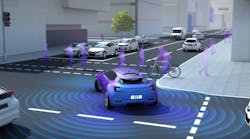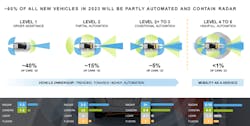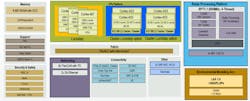What you’ll learn
- What types of radar are being used in cars.
- Key features of NXP’s latest radar chips.
Radar has become a mainstay for advanced driver-assistance systems (ADAS), and the single radar used for advanced cruise control is being augmented by half a dozen or more radar systems. By 2023, cars will have a mix of radar, LiDAR, and camera-based systems providing significantly more situational awareness to the driver, in addition to being used by self-driving car solutions (Fig. 1).
NXP Semiconductors has been a major supplier of radar technology for automotive applications. Its latest offering starts off with the TEF82xx radar transceiver (Fig. 2). A single chip can address a number of applications supporting 76- to 81-GHz bands with usable bandwidths up to 4 GHz. A 6-bit phase rotator enables advanced modulation MIMO and beamsteering support. Each chip incorporates three transmit and four receive channels. The 7.5- × 7.5-mm exposed die package provides enhanced thermal performance and is ISO26262 ASIL Level B compliant.
One or more TEF82xx chips can be paired with the new S32R294 and S32R45 4D imaging radar system-on-chip (SoC) solutions. The S32R294 addresses short-range corner and front/rear radar applications, while the S32R45 delivers advanced feature detection and classification support.
The S32R294 uses NXP’s Z-series Power-based processor cores (Fig. 3). The real-time Z4 cores operate in lockstep mode while the dual Z7 processors handle the application space. These double the performance of the earlier S32R274 SoC. This includes the performance of the Signal Processing Toolbox (SPT 2.8), which is used to handle up to two TEF82xx chips. The SPT support is compatible with older chips as well as the newer S32R45.
The S32R294 includes the CSE3 security module designed for secure over-the-air (OTA) updates. The SoC meets Automotive Grade 1 temperature specifications from −40 to 150°C. It’s also ISO26262 ASIL Level B(D) compliant.
The S32R45 marks NXP’s automotive migration to Arm Cortex platforms (Fig. 4). The SoC has multiple Cortex-M7’s operating in lockstep mode as well as a pair of Cortex-A53 applications cores. These also have a lockstep option.
As with the S32R294, the S32R45 is ISO26262 ASIL Level B(D) compliant and includes a 600-MHz, 4-thread version of the SPT. In addition, the S32R45 includes a linear algebra accelerator (LAX) that’s 64 times faster than the Cortex-A53 for these types of operations. The LAX and SPT significantly boost performance that’s tailored to radar applications.
Given that most applications for these platforms is written in C/C++ means that migration to this platform should be relatively easy. That’s because peripherals like the SPT is where code tends to depend more on the underlying hardware.
The chip has 8 MB of SRAM with ECC support as well as external DDR support. It features a PCI Express interface for handling additional peripherals as well as eight FlexCAN interfaces with CAN-FD support. Two Gb Ethernet ports are also included.
S32R45 can perform the same chores as the S32R294, but it’s able to handle feature detection and classification, too, which requires more compute power (Fig. 5).
That allows a system to identify different types of objects like people, cars, and animals instead of simply providing the system with a range to a general blob. As a result, the software will have a better understanding of the overall environment.






